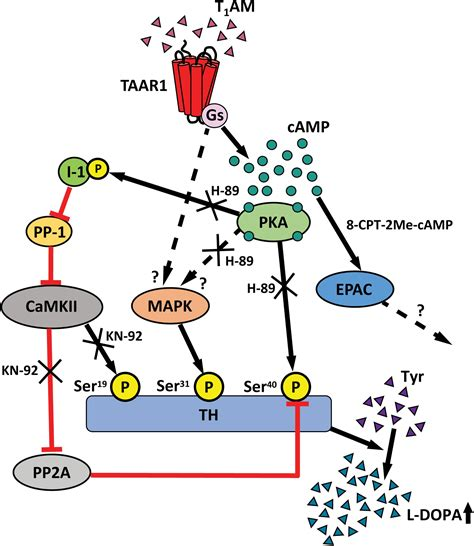Tyrosine Hydroxylase
links: reference: 4-24-2021
Tyrosine Hydroxylase (TH) #
-
Hydroxylates L-Tyrosine into L-DOPA.
-
Tyrosine Hydroxylase and Regulation of Dopamine Synthesis
- It is the rate-limiting step of Catecholamine synthesis since Dopamine binds to it competititvely against tetrahydrobiopterin, which TH uses along with oxygen.
- Something like that at least Tyrosine hydroxylase activity is regulated by two distinct dopamine-binding sites
- It is the rate-limiting step of Catecholamine synthesis since Dopamine binds to it competititvely against tetrahydrobiopterin, which TH uses along with oxygen.
-
- This may not be a big deal considering this happens with dopamine regardless.
-
- Forskolin, an activator of Adenylyl Cyclase, stimulated Tyrosine Hydroxylase phosphorylation at Ser40 and caused a significant increase in DOPA accumulation.
- NMDA reduced forskolin-mediated increases in both Ser40 phosphorylation and DOPA accumulation. NMDA reduced the increase in phospho-Ser40-tyrosine hydroxylase produced by okadaic acid, an inhibitor of protein phosphatase 1 and 2A.
- This paper thus concludes that In the Striatum, Glutamate decreases Tyrosine Hydroxylase phosphorylation at Ser40 via activation of NMDARs by reducing cAMP production.
- Yeah that reduction in cAMP is basically something I never thought of. It must be by proxy of Ca2+->CAM->PDE, or something else interesting with CAMK maybe? The CaMKII/NMDAR complex as a molecular memory
- This paper thus concludes that In the Striatum, Glutamate decreases Tyrosine Hydroxylase phosphorylation at Ser40 via activation of NMDARs by reducing cAMP production.
Residues #
-

- Ser19: Increases rate of Ser40 phosphorylation.
- Two-fold increase of activity through the 14-3-3 proteins.
- Ser31: Slight increase in activity. Two-fold lower KM for THB.
- Ser40:
- Dephosphorylated by PP2A.
- Protein Kinase A: Ser40 - alleviation of feedback inhibition. Two-fold lower KM for THB. and 300-fold decrease in catecholamine binding affinity.
- MAPKAPK2: 40, somewhat 19. Alleivation of feedback inhibition.
- ERK: 31, somewhat 8. Increases activation 2-fold.
- CDK5: 31.
- CAMK II: 19, 40 to a lesser extent. Binding of 14-3-3.
- PRAK: 19. Binding of 14-3-3.
- Ser19: Increases rate of Ser40 phosphorylation.